







 |
||||||
 |
 |
 |
 |
 |
 |
 |
The Care and Breeding of the Smooth Knob-Tail Geckos (Nephrurus levis levis)
by Justin Julander
Knob-tail geckos are some of the most
fascinating lizards in the world. Their large eyes, big heads,
and small tails make 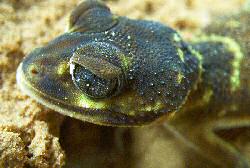
for
an odd combination resulting in a comical
appearance. They can be hardy and characterable captives if their
needs are properly met. As they are nocturnal and fairly
secretive, they may be come easily stressed from too much handling and
are 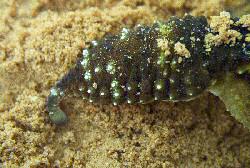
not a suitable pet gecko, but are
fun to watch and keep.
There are few caresheets on the web, and so hopefully this page can be
a help to anyone who wants to keep these awesome geckos. I have
been keeping and breeding these awesome lizards for a year and a half,
so I am by no means an expert, but with the help of some great friends
(thanks Casey and Jim!) I have been fairly successful in keeping these
geckos and am thoroughly addicted to these little gems. They
aren't too hard to keep as long as you recognize the important elements
of keeping them happy.
Important Natural History
Smooth knobs live in sandy areas and
spend much of their lives in burrows. They will make use of
burrows made by 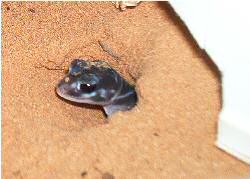
insects
or small mammals. They are also great
excavators and can dig an appropriate burrow quickly. Moisture is
retained by spending the hot hours of the day inside their
burrows. This is important to keep in mind when designing an
appropriate cage for your geckos. They are also nocturnal in
habit and will forage at night for insects and other geckos. They
are ravenous preditors and track and attack prey with vigor. They
may also wave their knob in anticipation of a meal. Little is
known about their natural history and much of what we know about these
lizards is from their behavior in captivity.
Caging
Knob-tails can be kept in many
different styles of cages, as long as specific needs are met. These
needs are appropriate thermal gradient, proper moisture retention, and
recognizable substrate. Provide a thermal gradient from mid 70's
on the cool end to high 80's on the warm end, which is easily
accomplished with apporpriately placed heat tape or a heating
pad. A digital thermometer or infrared temp gun can be used to
monitor temperature to make sure that it is not too hot for the geckos
when setting up the enclosure. I place a heating pad or strip of
heat tape on the dry end of the cage and the cool end is also the moist
end. This prevents the moist side from drying out too
quickly. A thermal gradient functions in giving the geckos usable
temperatures for jobs they need to do. I have observed my gravid
females as they spend time on the hot end while their eggs are
developing. In nature they will emerge from their burrows at
night and will warm themselves on the sand that has been heated during
the day, so this form of heat will need to be duplicated in
captivity. If they have proper heat then they can attain natural
life events. It is imperative when keeping reptiles to provide a
proper thermal gradient to suit their needs for different natural tasks
the animals must perform. Failing to do this or providing an
overall ambient temp is just trying to tell your animals what to use
without taking into consideration that they need many different temps
at different times to perform different biological processes.
The second important need to be met
is appropriate humidty. This is fairly easy to provide by
moistening slightly the sand at one end of the cage. Fine sand is
used with great results. I would also reccommend the use of
natural sand as opposed to processed sand made from crushed rock.
Natural sand is smooth and free of jagged edges, where processed sand
is like walking on glass shards. I am luck to live in Utah and
have some access to the nice red sand of southern Utah to use in the
gecko cages. The sand on the moist end must be moist enough that
it will clump when squeezed in the hand and which will hold a
burrow. You may also provide an inverted potting dish with a hole
cut in the side or rocks SECURELY stacked over the moist area. If
the sand is deep enough, the geckos will make their own burrows.
The entrance of the burrows or the opening provided in the inverted
container or terra cotta plant drainers will be plugged with sand to
retain the moisture in the burrow. If knob-tails aren't allowed
to burrow and close themselves in in this manner, they will soon
dehydrate with unfortunate results.
As mentioned above these geckos need
a natural recognizable substrate. Natural fine sand works
wonderfully. Don't keep these geckos on something they don't
recognize. If kept on newspaper, leaf litter, or other substrate,
they will not know what to do with it. It would be like us living
in our swimming pools; we could live there, but it wouldn't be that
great. I like to provide my females with an extra deep layer of
substrate (4-6 inches) so they can prepare for nesting. I have
used sand from nature with no problems. Once these simple needs
are met and maintained, they are easy to keep.
Feeding
Knob-tails in captivity will eat a
variety of insects including crickets, mealworms, superworms, locusts,
cockroaches and other appropraitely sized bugs. I dust the food
items with an appropriate calcium or multivitamin powder. They
can eat fairly large meals when compared with other geckos of similar
size, but care must be taken not to feed them too large of food
items. They hunt at night and emerge from their burrows early in
the evening, so they should be fed at that time. Don't throw
insects in the cage during the day or during the day when they are
sleeping or they will lose their dusting and can cause other
problems. Crickets will lay eggs in the moist end sand which will
hatch in the warmth and you'll have baby crickets everywhere. The
baby crickets will annoy and stress the geckos out alot, so it is a
good practice to pinch the ovipositors of the female crickets to make
sure no eggs are laid before feeding. If you notice baby crickets
in the cage, replace the substrate immediately to remove all the baby
crickets. Mist the cage once every couple of days in the summer
warm months and less frequently during the winter cool. If the
geckos are out, mist them as well and so they can drink, licking the
droplets off their face.
Breeding
These geckos are quite prolific and
give the chance will even lay themselves to death. This must be
kept in mind when preparing to breed. Breeding and egg production
tapers off and stops as the temperatures are reduced and as cage
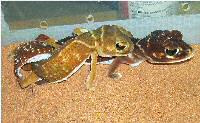 conditions
become
drier. Knob-tails, like many geckos will
produce clutches of two eggs and can multiclutch, laying many clutches
a season. Six clutches are about as many as you want to get from
any one female, and that only if they are healthy. If they are
cooled in the winter months and returned to warmer conditions in the
spring it is hard to stop these geckos from breeding. When introducing
pairs, I have noticed important signals which indicated weather the
female is receptive or not. If a male and female are placed
together and the female begins to raise her tail, wave the knobbed end
around, and thrust her cloaca in the face of the male, then she is NOT
ready. Non-receptive females will also vocalize and avoid males
when not receptive. I have noticed that when a female increases
food intake that she may be
conditions
become
drier. Knob-tails, like many geckos will
produce clutches of two eggs and can multiclutch, laying many clutches
a season. Six clutches are about as many as you want to get from
any one female, and that only if they are healthy. If they are
cooled in the winter months and returned to warmer conditions in the
spring it is hard to stop these geckos from breeding. When introducing
pairs, I have noticed important signals which indicated weather the
female is receptive or not. If a male and female are placed
together and the female begins to raise her tail, wave the knobbed end
around, and thrust her cloaca in the face of the male, then she is NOT
ready. Non-receptive females will also vocalize and avoid males
when not receptive. I have noticed that when a female increases
food intake that she may be 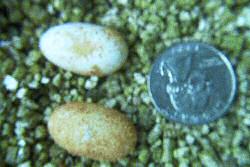 putting
on weight for egg production and
may be more receptive to a male. Receptive females are very easy
to discern from non-receptive females. They will lie still as the
male approaches with their tail down and quiet and submissive in
behavior. A male will generally immediately show interest and
will begin by grasping the female by the nape the tail and eventially
moving up to the nape of the neck. The female will sometimes move
her tail over the tail of the male. He will begin breeding the
female and breeding will last several minutes. The geckos are in
a semi-trance state and are not easily disturbed. I once had a
female that was not in proper breeding condition that I placed in a
males cage for a couple minutes for a cage cleaning. I came back
to remove the female, but the male was firmly attached and wouldn't let
go for the world. I even picked the pair up and he still refused
to let go. They sure are exhibitionists.
putting
on weight for egg production and
may be more receptive to a male. Receptive females are very easy
to discern from non-receptive females. They will lie still as the
male approaches with their tail down and quiet and submissive in
behavior. A male will generally immediately show interest and
will begin by grasping the female by the nape the tail and eventially
moving up to the nape of the neck. The female will sometimes move
her tail over the tail of the male. He will begin breeding the
female and breeding will last several minutes. The geckos are in
a semi-trance state and are not easily disturbed. I once had a
female that was not in proper breeding condition that I placed in a
males cage for a couple minutes for a cage cleaning. I came back
to remove the female, but the male was firmly attached and wouldn't let
go for the world. I even picked the pair up and he still refused
to let go. They sure are exhibitionists.
I keep pairs together until the
female is noticably gravid, at which time I remove the male to another
cage. The female will begin to dig and will really rearrange the
sand. Many times you will know when the female has laid by the
amount of sand that has been kicked around the cage. If the
substrate is not deep enough or the female does not find a spot to her
liking, she may retain the eggs longer and this may lead to
problems. Make sure that you have sufficiently deep (around 3-6
inches), slightly moistened, sandy substrate. My females
generally dig down to the bottom of the container and lay the eggs on
the surface of the rubbermaid container. They will sometimes
leave air around the eggs if the substrate is too moist. They do
a good job of placing the eggs in the best environment available.
Carefully dig up the eggs and incubate them around 82-85 degrees.
Incubate on slightly moistened vermiculite. There should be a bit
of condensation on the sides of the incubation chamber. Don't
overwater, as less moisture is less harmfull than too much.
Monitor the eggs occasionally to make sure they appear healthy and that
they have not died during incubation. Healthy eggs will generally
not mold, and I have even had moldy eggs hatch into healthy
babies. They will take around 60 to 70 days to hatch. The
babies are kept individually as the adults and are fed on small insects
that are dusted. This is a rewarding and fascinating species to
keep. Have fun, and get addicted!
Knob-tails Rule!